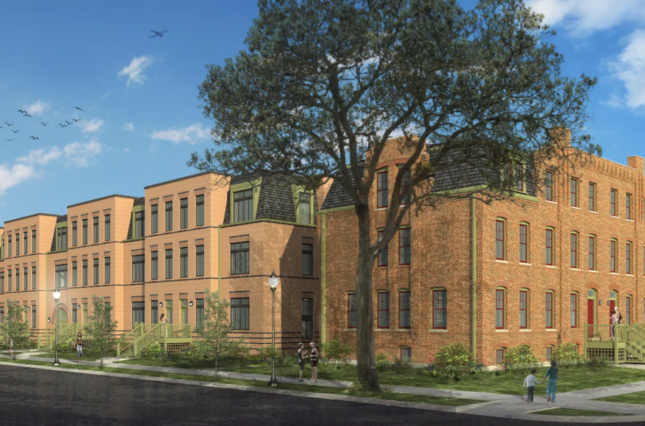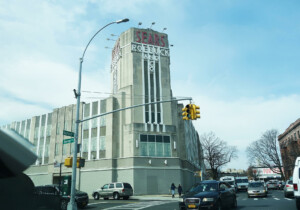Two controversial community battles in Chicagoland could redefine how historic preservation crusades are fought and won in our overheating national political climate. Both issues highlight how earnest and ethical historic preservation advocacy efforts are being overshadowed by those that are no more than thinly disguised manifestations of NIMBYism supercharged by a culture of divisiveness.
In Pullman, originally a planned community outside of Chicago built for Pullman Palace Car Company employees, some residents have banded together to oppose proposed affordable housing for artists over concerns that the construction would destroy an archaeological site: the foundation of ‘Tenement B,’ one of the historic workers’ homes. Members of this group, the Pullman National Monument Preservation Society (PNMPS), have gone after public-sector historic preservation entities and the Section 106 regulatory process, arguing the proposed artists’ housing will have an ‘adverse effect’ on the site.

Pullman became Chicago’s first National Monument in 2015, and it is one of the oldest. At Pullman’s peak, 20,000 factory workers lived and worked under an autocratic system, controlled wholly by the Pullman Palace Car Company, which owned the town’s housing, factories, stores, and churches, all planned and designed in the 1880s by architect Solon S. Beman. After workers rioted over wage decreases and the company’s refusal to reduce rents, the Illinois Supreme Court ordered that all non-factory buildings be sold in 1897. Faced with demolition in 1960, the Pullman Civic Organization (PCO) was formed, establishing a foundation for future preservation efforts. By 1973 Pullman had been added to federal, state, and local landmarks lists and the Historic Pullman Foundation was formed, which went on to restore the Hotel Florence and organized the ever-popular house and garden tour.
In the summer of 2015, Chicago Neighborhood Initiatives (CNI) along with VOA Associates (now part of Stantec) introduced a plan to construct the first new rental housing in Pullman in over 50 years. Artspace Lofts would bring affordable artist housing and studio space to an empty lot on Langley Avenue just south of 111th Street. The new development would join two existing historic tenement houses, with the overall project scope including the restoration of both tenements to federal historic preservation standards. The project’s site was once the home of a tenement building, demolished in 1938. A fragment of the original limestone foundation is present, as the site was never redeveloped.
Pullman residents generally supported the Artspace Lofts plan. Pullman’s status as a National Historic Landmark meant that the project required a detailed federal and local review, but a small group of residents called foul, claiming that not enough was being done by historic preservation organizations to prevent the new development from being constructed and that the sanctity of the landmark was now at risk. The PNMPS was formed.
Among the PNMPS’s original claims is that the Artspace Lofts will destroy the limestone foundation and “the associated artifacts” of the tenement building, the remnants of which PNMPS believes to be an archaeological resource, yet PNMPS has also stated that they would accept a reconstruction of Tenement B using the existing limestone foundation. Unlike the recent discovery of remnants of Mecca Flats underneath the IIT campus, which revealed never-before-seen colors and textures of the long-demolished building, further investigation or preservation of the remnants of Tenement B would not enhance existing knowledge of Pullman.
PNMPS has gone after the regulatory processes of the National Park Service, the Illinois State Historic Preservation Office, and the City of Chicago, calling out staff members by name for what they claim to be a botched Section 106 review for the Artspace Lofts. This includes PNMPS’s unsubstantiated claim that the Section 106 review did not include African-American groups as any of the forty local consulting parties, with PNMPS playing a game of virtue signaling within the neighborhood that grew the Brotherhood of Sleeping Car Porters.
On social media PNMPS has dragged the National Trust for Historic Preservation for supporting the project and has posted photos to Instagram of developers and architects working at the site, presumably to expose their identities. Despite the complex explanation of the National Historic Preservation Act and the Section 106 process posted to its website (as well as this bizarre video, including footage from a South Park episode about gentrification and Donald Trump’s inauguration) and other thinly veiled claims attempting to draw attention away from NIMBYism, quotes by Mark Cassello, the president of PNMPS, to the Chicago Tribune in 2016 distill the organization’s real objective: “Pullman doesn’t need to attract artists, they are already here. Pullman doesn’t need affordable housing.” With CNI and Stantec having received all of the necessary approvals, ground is expected to be broken on the Artspace Lofts this fall.
Across town, the Evanston City Council recently moved forward with a plan to allow the Evanston Lighthouse Dunes (ELD), to pay for the demolition of the Harley Clarke Mansion, a local historic landmark on Sheridan Road. While the 1927 Tudor revival mansion, designed by architect Richard Powers, boasts impressive architectural features, Evanstonians remember it as the place where they learned to dance, paint, and draw, and when the building was a lakefront art center. Harley Clarke housed the Evanston Art Center for fifty years, providing people of all incomes with their own opulent lakefront mansion. As the city prepared to close the art center over deferred maintenance costs in 2015, several offers were made to take it off the city’s hands, including one that proposed a hotel on the property, and another by the Illinois Department of Natural Resources. A committee was formed to study uses for the mansion, and a request for proposals was introduced.
Late in 2015, a non-profit volunteer group, Evanston Lakehouse & Gardens (ELHG) formed to restore and repurpose Harley Clarke as a public space, initially working closely with city staff to develop a plan that would work similarly to the lease held by the Evanston Art Center, but would include a stipulation that allowed ELHG to build a capital campaign, as the organization lacked the funds upfront for repairs. The City of Evanston initially approved a lease agreement with ELHG in early spring of 2018, but the plan was redacted at the council level, with the city council claiming that ELHG did not present a sound financial proposal. ELHG counterclaims that the city never allowed them to use pledges as fundraising benchmarks, placing the organization in a difficult position, but one that they worked with the city directly to negotiate. Despite this setback, ELHG continues to advocate for the Harley Clarke Mansion, a contributing property to a National Register of Historic Places landmark district, and a City of Evanston local landmark.
In May of 2018, Evanston aldermen introduced a proposal by ELD to pledge $400,000 towards the demolition of the mansion. ELD has justified the demolition as a way to absolve Evanston of the financial burden of deferred maintenance and upkeep, as well as a way to open up the lakefront to the public, restore the natural setting of the beach and dunes, and improve the viewshed of the neighboring Grosse Point Lighthouse. According to ELD, demolition of the mansion would also honor the City of Evanston’s Lakefront Master Plan. Conveniently, the demolition of Harley Clarke would also ensure that no public or private entity could gain ownership or operation of the mansion, be it a boutique hotel or a public art center.
While ELD has not disclosed a list of funders, those that have publicly aligned themselves with the organization live nearby, leading to speculation that the demolition of Harley Clarke might provide ELD members with precious views of the lakefront. Views of Lake Michigan would be a boon to real estate values in a neighborhood where home values hover just below $2 million. This has led to the speculation that the 41 individuals, couples, and one family organization that have provided money to ELD may include city leaders, explaining the ability for a previously unknown organization to get out in front of city government so quickly and so easily.
The ELD has recently offered to pay for the full price of demolition and restoration of the dunes and Jens Jensen garden, but has stated that the money will only be available to the City of Evanston for two years. Recently softening their preservation ordinance yet still welding substantial power to prevent new construction in historic districts, the City of Evanston needs only to remove the mansion from their list of local landmarks in order to capitalize on private funds for demolition. This differs from the complex matrix in play to review the proposed Obama Presidential Center in Jackson Park, which includes consultation with local and federal agencies.
Perhaps the cases in both Pullman and in Evanston echo a larger national political trend of Trumpian normalcy now seeping into historic preservation. Attacking long-standing organizations and entities when they come down with a less than ideal determination is becoming acceptable behavior, and the public sector can be increasingly enticed with private money to do things that affect a greater population that lack the funds to influence political decisions. These changes, combined with historic preservation’s tendency to turn a blind eye to any accusation of NIMBYism, whether accurate or not, weaken the field’s ability to protect historic resources for the good of our collective culture. As the larger field of architecture works towards a long-overdue reset of abusive practices within it and associated with it, historic preservation, too must take a timely look at how its tactics are implemented, and who will benefit from them.











